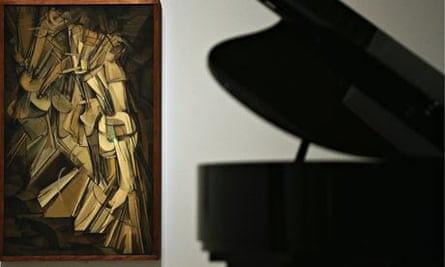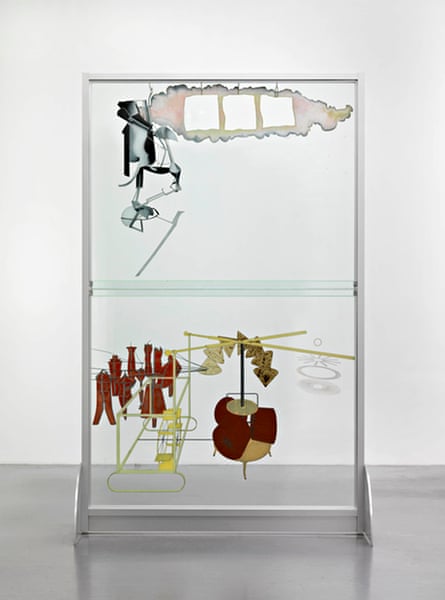Artist
'I don't believe in art. I believe in the artist.'
Bicycle wheel
The original Bicycle Wheel readymade from 1913, and a second version, were lost. The third has a curious story. In 1995, a man walked into New York's MoMA and stole the third version from the gallery. The thief left the building unnoticed, then returned the artwork the next day by throwing it over the wall of the sculpture garden.
Breasts
Duchamp used 1,000 foam-rubber breasts for the catalogue covers of the Paris exhibition Le Surréalisme in 1947. The back covers read 'Prière de toucher', or 'Please touch'.
Cheese
During the second world war, Duchamp devised a scheme to transport his artistic materials out of Europe. On the way to the US, he passed through Nazi checkpoints in Paris posing as a cheese merchant. Luckily, he did not arouse suspicion.
Chess
The game occupied him so much that, out of jealousy, his first wife, Lydie Fischer Sarazin-Levassor, glued his chess pieces to the board. The marriage lasted seven months.
Drugs
Duchamp's friends maintained that chess was his only drug. He made a point of never having smoked opium with artist Francis Picabia during their Paris heyday in the 1910s. The one occasion he took LSD was late in life, and it was slipped to him without his knowledge. According to Teeny, it was the only time she had to remove his shoes before bed.
Ejaculation
Duchamp kept quiet about using sperm in Paysage Fautif, or Faulty Landscape. It was only identified as such in 1987, by FBI laboratories in Houston, Texas, where the work was presented to the public for the first time.
Food
His favourite foods were chocolate, pastrami and crisp French fries.
Fountain
The original version of the 1917 urinal Fountain was lost without ever being publicly displayed.
He used the pseudonym R Mutt to conceal his authorship when he sent the work to an exhibition of the Society of Independent Artists in New York. The show's organisers, among them Duchamp himself, rejected the entry, which led to the resignation of Duchamp and other committee members. His friend Beatrice Wood defended the choice of object, saying "the only works of art America has given are her plumbing and her bridges".
Peggy Guggenheim
Although "every woman in Paris wanted to sleep with him", Guggenheim and Duchamp ended up some time in the late 20s not hooking up in the French capital as they "wandered around all night longing to go to bed together". In her memoirs, Duchamp gets full credit for introducing the socialite to modern art. There was a longstanding rumour that Duchamp once suggested cutting 20cm off a Jackson Pollock so it would fit into her townhouse.
Hair
Duchamp had only two phobias: flying in an airplane, and an "almost morbid horror of hair", according to his first wife. In 1920, Man Ray and Duchamp shot a movie – destroyed in development – of Man Ray shaving the pubic hair of a nude model.
Herne Bay, Kent
Duchamp went to Herne Bay with his sister in 1913. Some of the most important sketches of the Large Glass were done there. What held his attention was the new Grand Pavilion, which was lit up at night on the pier. In one scrap of paper he imagines "as background, perhaps: An electric fête recalling the decorative lighting of Magic city or Luna Park or the Pier Pavilion at Herne Bay ..." So Herne Bay inspired him to realise the iconic work on glass rather than canvas.
Interviews
90% of his public interviews are from the time between his mid-60s and his death in 1968 aged 81 – so almost everything is seen through the eyes of an elderly man reflecting back.
Jobs
At different points in his life, Duchamp was the following: professional chess player, self-publisher, painter, volunteer for military service, art dealer, gambler, inventor, librarian, secretary to a French war mission in the second world war. He also dabbled in cleaning and fabric-dying businesses, thought of becoming a professional cameraman and was eager to market self-designed chess sets, optical machines and scientific toys.
Kandinsky
To Duchamp, who could also have been writing about himself, Wassily Kandinsky's real contribution to art was a "deliberate condemnation of the emotional".
L.H.O.O.Q.
In 1919, he pencilled a goatee on to a reproduction of Leonardo's Mona Lisa. Its title is a pun if the letters are pronounced in French: "Elle a chaud au cul', or 'She has a hot ass'.
R Mutt
Duchamp claimed the word "Mutt" was inspired by the cartoon Mutt and Jeff, and the company JL Mott Iron Works of Trenton, New Jersey, where he claimed to have bought the urinal.
Nude Descending a Staircase No 2
President Theodore Roosevelt compared the painting unfavourably to a Navajo rug. The Nude's first owner bought it for $324. It is now estimated to be worth over $100m.
Outcry

In 1913, at New York's Armory show, Nude Descending a Staircase No 2 was described with mockery as "an explosion in a shingle factory" or depicted as 'The Rude Descending the Staircase (Rush Hour in the Subway).
Philadelphia
In the movie Rambo, Sylvester Stallone plays a Vietnam war veteran, pronounced like the 19th-century French poet Arthur Rimbaud. One iconic scene shows the actor running up the steps to the Philadelphia Museum of Art. In the boxing drama Rocky, these steps also feature prominently. The Philadelphia Museum of Art collection contains most of Duchamp's major works, including Nude Descending a Staircase No 2, Large Glass, and all of his readymades. For Rocky III, a bronze statue was placed on the steps. Its location triggered a decades-long debate about what is art and what is not – all within the vicinity of the readymades which started it all.
Pablo Picasso
Duchamp told an interviewer in 1933 that "the modern artist must hate Picasso in order to make something new". It was because of Duchamp's rising influence that an ever-competitive Picasso came to despise him. When he learned of Duchamp's death, he said, after a long pause, "He was wrong!", while proclaiming of contemporary artists, "They loot Duchamp's store and change the wrapping."
Quick art
"Quick art, that's been the characteristic of the whole century from the cubists on. The speed that's being used in space, in communications, is also being used in art. But things of great importance in art have always to be slowly produced." Duchamp sometimes took 20 years to create a single artwork.
Readymade
Duchamp made no effort to exhibit readymades for four decades, and said they were "a very personal experiment that I never intended to show the public".
Henri-Pierre Roche
Despite much speculation, the love triangle of Jules, Jim and Catherine immortalised in Truffaut's film Jules and Jim was not inspired by the romance of Roche and his friend Duchamp with the artist Beatrice Wood in New York in the 1910s.
Roche kept a diary, in which his sexual exploits are meticulously listed. Through Roche, we know of Duchamp's amorous adventure with three young women – and his penchant for "very vulgar women" as lovers.
Alexina Sattler (Teeny)
In 1954, Duchamp married Sattler, the former wife of art dealer Pierre Matisse and son of the painter Henri Matisse. Teeny's daughter later remembered: "My mother told me that at one point Henry Miller had a crush on her, but he was rather vulgar ... whereas Marcel had a very light touch."
Transformer
On paper, Duchamp invented a "transformer designed to utilise wasted energies", among them exhaled tobacco smoke, urine and excrement, ejaculation and tears. More than 50 years later, in 2008, the Biomechincal Energy Harvester came into being.
Unrealised projects
As well as leaving the Large Glass unfinished, Duchamp left papers about unrealised projects. While some notes published in his lifetime mention things that did not need to be acted upon – like using a Rembrandt as an ironing board – the notes that became available posthumously include the following: "take one cubic centimetre of tobacco smoke and paint the exterior and the interior surfaces a waterproof colour"; "trace a straight line on Rodin's The Kiss as seen from a sight".
Vagina
"I want to grasp things with the mind the way the penis is grasped by the vagina."
Work
"I would have wanted to work, but deep down I'm enormously lazy. I like living, breathing, better than working. I don't think that the work I've done can have any social importance whatsoever in the future."
X-rays

Duchamp's Large Glass has been called "the first X-ray painting of space".
Young Man and Girl in Spring
This 1911 painting was a wedding gift for his sister Suzanne. While some analysis includes allusions to homosexual intercourse, Kabbalism and tantrism, it has also been proposed that, for once, Duchamp made a work about the joys of marriage.
Marius and George de Zayas
The Mexican-born artist and art critic Marius de Zayas was vital in introducing contemporary art to the US. But Duchamp was reluctant to feature in any of his shows. He only appeared in one, The Evolution of French Art – From Ingres and Delacroix, and the catalogue listed the works under the name "Marcelle Duchamb".
This is an extract from The Duchamp Dictionary by Thomas Girst, published by Thames & Hudson, £16.95.

Comments (…)
Sign in or create your Guardian account to join the discussion